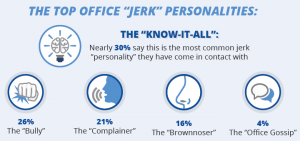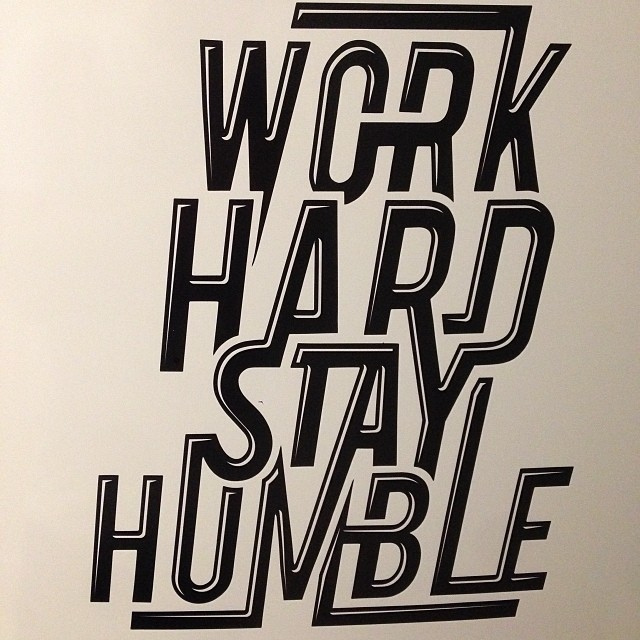|
|
|
Wednesday, July 31st, 2019

Monday was about dealing with jerks in your workplace and yesterday about managing lazy co-workers.
What about bosses? Where are they? Why is it being left to workers to deal with problem co-workers?
Over the years (decades, actually), I’ve heard all the excuses — ‘I can’t be everywhere’, ‘I’m working on it’, or the ubiquitous ‘I’m busy’.
Those are the “good” excuses; here are the bad ones — ‘they’re really good at [whatever]’, ‘they’re a friend/relative of X’, ‘they’ve been here since the beginning’, and, in some ways, the worst ‘deal with it’.
Being self-motivated and self-managing should not include having to manage your colleagues.
That’s the boss’ job and why they make the bigger bucks.
I’ve never forgotten what Terry Dial, who eventually became vice chairman of Business Banking at Wells Fargo, told me decades ago when I was a recruiter, “People are 90% of our costs as well as the key to customer service and satisfaction. The only thing that should take priority over hiring a new employee is keeping a current one.”
That hasn’t changed in all these years.
Which begs the question, what are the bosses doing?
Avoiding direct interactions by hiding behind social media and chat apps, just as they hid behind email and, before that, memos.
Sometimes it’s because they are promoted in spite of not being a “people person,” which has nothing to do with whether they are extroverts or introverts.
Good bosses know that when someone is messing up, hurting or one of the other myriad causes of less than optimum behavior, it’s their responsibility.
Period.
No ifs, ands, buts, or excuses.
Image credit: Jordan Davis
Posted in Communication, Culture, Motivation, Retention | No Comments »
Monday, July 29th, 2019
 (see the full Infographic at Business Insider) Poking through 13+ years of posts I find information that’s as useful now as when it was written.
Golden Oldies is a collection of the most relevant and timeless posts during that time.
People. Whether at work or in your personal life, how you choose to respond to people is usually the make or break of any situation. That is especially true when dealing with someone’s negative actions.
Read other Golden Oldies here.
I’m in love — with a man I never met, never spoke to, never followed or chatted with online.
His name is Rich Waidmann and he’s founder and CEO of Connectria Hosting.
I love him because when he started his company he consciously set out to make it a great place to work.
That means it’s a job requirement at his company that every employee treat everyone else with courtesy and respect as well as “going the extra mile” to take care of people in the community who are less fortunate
Then his company did a survey and found that
More than half (55%) of 250 IT professionals in the US. surveyed said they had been bullied by a co-worker. And 65% have said they dreaded going to work because of bad behavior of a co-worker.
Waidmann believes it shouldn’t be that way so he’s starting a No Jerks Allowed movement in an effort to encourage better cultures.
Way back in 2007 Stanford’s Bob Sutton wrote The No Asshole Rule: Building a Civilized Workplace and Surviving One That Isn’t, but looking at the stats I’m not sure how much good it actually did.
And considering the fact that companies are shoehorning more people into less space something needs to change.
The Talmud says, “We do not see the world as it is. We see the world as we are.” Moreover, it’s often as we are that particular day, or even minute, and even as we change, minute to minute, so do others.
Jerks are known to lower productivity and kill innovation, so a lot of good information on identifying and dealing with jerks has been developed since Sutton’s book came out.
Contributing to that effort, here are my four favorite MAP attitudes for dealing with jerks.
-
- Life happens, people react and act out, but that doesn’t mean you have to let their act in.
- Consider the source of the comment before considering the comment, then let its effect on you be in direct proportion to your respect for that source.
- Use mental imagery to defuse someone’s effect on you. This is especially useful against bullying and intimidation. Do it by having your mental image of the person be one that strips power symbols and adds amusement. (Give me a call if you want my favorite, it’s a bit rude, but has worked well for many people.)
And, finally, the one I try to keep uppermost in my mind at all times
-
- At least some of “them” some of the time consider me a jerk—and some of the time they are probably correct.
Image credit: Connectria
Posted in Communication, Culture, Ducks In A Row, Personal Growth, Retention | No Comments »
Friday, March 8th, 2019

A Friday series exploring Startups and the people who make them go. Read all If the Shoe Fits posts here.
A couple of years ago Dick Costolo explained why startups needed to hire “brilliant jerks” in order to succeed.
It’s stuff like that, especially from people like Costolo, that gives people permission to act like jerks.
Why?
Because people who tend to be jerks are usually delusional enough to believe that they’re brilliant.
But what about those who are brilliant (or what passes as such these days) and act like jerks?
Well, why not?
All they are doing is living up to expectations and, like Pavlov’s dog, the more free passes they get the more they will believe their actions/attitudes are OK.
In my life I’ve been around a lot of real brilliance and they had certain traits in common.
Without exception, they loved sharing their knowledge, building up those around them and helping them grow — no matter who.
That’s what truly brilliant people do; that’s why they are remembered.
The same goes for everyone who does the same.
Whereas the jerks are ephemeral and soon forgotten.
If they are remembered, it’s for what they did, as opposed to how they acted.
Steve Jobs is a good example, as is Jeff Bezos.
Think about it; what’s the likelihood that the brilliant jerks in your world are in the same league?
Image credit: HikingArtist
Posted in Culture, Hiring, If the Shoe Fits | No Comments »
Wednesday, March 6th, 2019

There’s enough career and how-to-be-successful advice to fill a stadium. It goes back decades; some is out of date in a digital world, but the best stuff isn’t.
- The lesson: Go in with big eyes, big ears, and most importantly don’t be a jerk.
- You can be the most talented and skilled at your job, but if people don’t like you, your success will be limited.
Such was the advice that was given to Corey Burns 12 years ago by a mentor.
He recently gave it to a colleague and it’s just as relevant now as it was then.
It’s also one of the true pearls of wisdom that, if we are paying attention, we each collect in the course of our lives.
The best advice, such as this, is so simple it can be offered in less than two minutes and understood almost instantly. (Click the link for a detailed explanation.)
But practicing it seems to be the biggest obstacle for a lot of people.
Watch, listen, don’t be a jerk.
- Make it your mantra; the thought that guides your words and actions;
- surround yourself with like-minded people; and
- avoid those who scoff and do the opposite, especially in the workplace.
Simple.
So, as Nike would say, just do it.
Image credit: Aaron Gustafson
Posted in Culture, Personal Growth | No Comments »
Tuesday, March 5th, 2019

(‘Jerk’ is used here as an umbrella term for bullies, manipulators, bigots, rotten attitudes, rudeness, cruelty, etc.)
Jerks have been around since the dawn of man.
In today’s workplace you can find jerks at any level of an organization.
It’s always been difficult to call out the jerks, because they are usually bullies and good at intimidation.
The rise of individual jerks, some of them extremely powerful, has fostered the rise of institutional jerks, also very powerful.
Some are in tech and run for companies that are household names — Facebook, Google, Amazon — others aren’t as well-known, such as Palantir.
However, you can find them everywhere, in politics — national, regional and local. In religion — any of them. And any other arena you want to focus on.
Their power is more far-reaching and they believe they are untouchable.
Sadly, they often are.
But how much worse is it when the institution itself is the jerk?
Talk about untouchable.
WeWork is on a role to lead the newest crop of institutional jerks.
The company acquired and plans to monetize software that tracks employees throughout a company.
Euclid’s website says the company is “focused on redefining the workplace experience of the future.” Translation: optimizing every aspect of the physical workplace so workers are their most productive.
Euclid does this by tracking how people move around physical spaces. Its technology can track how many people showed up to a meeting or to that after-work happy hour. The company can see where employees tend to congregate and for how long. It’s all done over Wi-Fi.
Sound creepy?
It is.
Governments are getting into the act, too.
While the legislation varies slightly from state to state, it generally requires contractors to install software that allows “automatic verification” of their hours billed. Some bills, such as those being considered in New Jersey, Pennsylvania and Rhode Island, are as exact as requiring a software solution that takes screenshots of “state-funded activity at least once every three (3) minutes” and store that data for seven years. The New Jersey and Pennsylvania proposals also require logging “keystroke and mouse event frequency.”
Now comes the question that the jerks never seem to think about.
How do you recruit talent, let alone top talent, into an environment that says up front, “we don’t trust you”?
As for the private sector, there is no way that any kind of monitoring or surveillance will remain secret — any more than salaries did.
Companies that choose not to go down that road will enjoy a more productive, creative and loyal workforce, not to mention one heck of a recruiting edge.
Image credit: Steve Baker
Posted in Culture, Ducks In A Row, Hiring, Motivation, Retention | No Comments »
Monday, March 4th, 2019

Poking through 11+ years of posts I find information that’s as useful now as when it was written.
Golden Oldies is a collection of the most relevant and timeless posts during that time.
Jerks, by whatever name, have been on the rise for awhile, but that seems to have escalated in the last couple of years, especially in the workplace. Not that jerk bosses are anything new, but they are getting more blatant.
Read other Golden Oldies here.
Although both articles I refer to are aimed at startup founders, I believe they are applicable to bosses at any level and in any company.
First, no boss ever accomplished their goals by being a jerk.
As Bob Sutton explains in The Asshole Survival Guide, treating people like dirt hurts their focus and saps their motivation. (…)
In the podcast, Reid [Hoffman] describes his test of a great culture: Does every employee feel that they personally own the culture?
Most jerks, no matter how unlikely that the comparison is valid, point to Steve Jobs to justify their actions, but consider how much more he could have done if he had been a better leader/manager..
It’s hard to find any boss who doesn’t recognize that culture is the most critical element in a company’s success.
However, what “culture” is has been twisted and warped out of all recognition.
These days “cultural fit” is the excuse of choice to indulge whatever biases, prejudices, and bigotry moves the hiring boss.
So, what does cultural fit really mean?
To answer that you have to understand what culture really is.
Culture is a reflection of the values of the boss.
Values have nothing to do with perks, food, or office buildings and everything to do with attitudes such as fairness, merit, transparency, trust, etc.
The point of cultural fit is to hire people whose personal values are, at the least, synergistic with the cultural values of the company.
Period.
That means that if the boss is biased, bigoted or a jerk, they will hire people who have similar values.
Image credit: Matthias Forster
Posted in Culture, Ducks In A Row, Golden Oldies | No Comments »
Monday, February 25th, 2019
 Poking through 12+ years of posts I find information that’s as useful now as when it was written. Poking through 12+ years of posts I find information that’s as useful now as when it was written.
Golden Oldies is a collection of the most relevant and timeless posts during that time.
Ryan’s post a couple of weeks ago reminded me of something I’ve wrote a long time ago.
The sum of it was not that great but in the moment it was contentious. Emails and gnashing of teeth on both sides. In that moment I was angry, but I chose to wait to respond.
My solution? Sleep.
Good solution, but when you’re a boss and something happens that makes you angry you usually can’t wait until the next day to deal with it.
So what do you do? Here’s a solution from the 1970s (and before). It worked then, it works now and it will work in the future.
Read other Golden Oldies here.
How angry do you become when you ask your team or colleague for X and get X — 4, or X + 1. or even Y? How often have you lost, or almost lost it, because of the response you received during a meeting?
What is the only perfect response you can make when something happens and you’re ready to blow your top?
You’ve heard the answer all your life—when you’re angry, shut up/stay quiet/ don’t say anything; don’t “look” anything, either, until you’ve calmed down. Smart advice, but hard to follow.
Many managers don’t even realize when they go into “screaming mode,” because they don’t actually scream—they drip sarcasm, leak contempt, stream scorn or fire off zingers; they belittle and role their eyes. Most don’t realize the long-term damage that they do to their people; others just don’t care—their attitude is that stuff happens, get over it!
What neither type seems to realize is that, over time, one of three things happen,
- people grow inured to their tantrums,
- are damaged by them (people do stay in abusive relationships),
- or leave the company.
To change this,
- you must first acknowledge to yourself that you do it and that you want to change it; then
- whenever you feel yourself getting angry smile, nod and leave by saying that you have to make a call, use the bathroom, whatever innocuous excuse best fits the situation;
- go somewhere private, blow off steam if necessary, but calm down;
- schedule a time to resume the discussion; then
- simulate the least amount of anger (if any) needed to get your point across.
It’ll take people time to trust the “new” you, but it’s worth it. In the office, it will pay off in higher productivity and less turnover. You and your people will suffer less from stress, and you, personally, will have more energy, enjoy higher quality sleep, and see improvement in all your relationships
Image credit: istolethetv
Posted in Communication, Culture, Golden Oldies, Motivation, Retention | No Comments »
Tuesday, July 11th, 2017
 Although both articles I refer to are aimed at startup founders, I believe they are applicable to bosses at any level and in any company. Although both articles I refer to are aimed at startup founders, I believe they are applicable to bosses at any level and in any company.
First, no boss ever accomplished their goals by being a jerk.
As Bob Sutton explains in The Asshole Survival Guide, treating people like dirt hurts their focus and saps their motivation. (…) In the podcast, Reid [Hoffman] describes his test of a great culture: Does every employee feel that they personally own the culture?
Most jerks point to Steve Jobs to justify their actions, but consider how much more he could have done if he had been a better leader/manager.
It’s hard to find any boss who doesn’t recognize that culture is the most critical element in a company’s success.
However, what “culture” is has been twisted and warped out of all recognition.
These days “cultural fit” is the excuse of choice to indulge whatever biases, prejudices, and bigotry moves the hiring boss.
So, what does cultural fit really mean?
To answer that you have to understand what culture really is.
Culture is a reflection of the values of the boss.
Values have nothing to do with perks, food, or office buildings and everything to do with attitudes such as fairness, merit, transparency, trust, etc.
The point of cultural fit is to hire people whose personal values are, at the least, synergistic with the cultural values of the company.
Period.
That means that if the boss is biased, bigoted or a jerk, they will hire people who have similar values.
Image credit: Matthias Forster
Posted in Culture, Ducks In A Row | No Comments »
Friday, April 21st, 2017
A Friday series exploring Startups and the people who make them go. Read all If the Shoe Fits posts here.
 I have some great links for you today. I have some great links for you today.
Yes, I realize I’m preaching to the choir and that those who really need to see this won’t.
Unless, of course, you forward it to where it’s most needed.
I’m sure you are tired of my griping (ranting?) about the bro culture, but maybe you’ll feel better knowing that bro culture dates back to ancient Greece, although knowing doesn’t make it any more palatable.
Philosophers are the original, archetypal “brilliant jerks.” And hundreds of years have done little to change that.
It’s not surprising how many brilliant jerks have an “I’m the next Steve Jobs” mentality, which is rarely warranted — true genius is all around us, including the urban ghettos — and gravitate to startups.
So what does a life of true brilliance, genius, if you prefer, look like?
It looks like Robert W. Taylor (died 4/2017) who, in 1968 said, “In a few years,” he wrote, “men will be able to communicate more effectively through a machine than face to face,” and then proceeded to make sure it happened.
Even more so, it looks like John Goodenough.
In 1946, a 23-year-old Army veteran named John Goodenough headed to the University of Chicago with a dream of studying physics. When he arrived, a professor warned him that he was already too old to succeed in the field.
Recently, Dr. Goodenough recounted that story for me and then laughed uproariously. He ignored the professor’s advice and today, at 94, has just set the tech industry abuzz with his blazing creativity. He and his team at the University of Texas at Austin filed a patent application on a new kind of battery that, if it works as promised, would be so cheap, lightweight and safe that it would revolutionize electric cars and kill off petroleum-fueled vehicles. His announcement has caused a stir, in part, because Dr. Goodenough has done it before. In 1980, at age 57, he coinvented the lithium-ion battery that shrank power into a tiny package.
Stupid professor, along with as all those who believe that creativity is an act reserved for the young.
Image credit: HikingArtist
Posted in If the Shoe Fits, Innovation, Role Models | No Comments »
Monday, April 3rd, 2017
It’s amazing to me, but looking back over more than a decade of writing I find posts that still impress, with information that is as useful now as when it was written.
Jerks. Turks. Stars. Bro culture. Definitely insanely stupid. I wrote this exactly six years ago and nothing has changed; if anything, it’s gotten worse and the post is yet more applicable.
Golden Oldies are a collection of what I consider some of the best posts during that time.
Read other Golden Oldies here.
 Are you already a devotee of insanely smart hiring, in the process of changing after reading insanely stupid hiring or somewhere in-between? Are you already a devotee of insanely smart hiring, in the process of changing after reading insanely stupid hiring or somewhere in-between?
Wherever your MAP is on the subject there is one thing about hiring that you need to wrap your head around if you want your career to flourish.
You can not hire stars, but you can create and maintain them.
This is as true of executives and management as it is of workers at all levels.
Think of hiring in terms of planting a garden—only these plants have feet.
You’re at the nursery and find a magnificent rose. It’s large, because it’s several years old, has dozens of blooms and buds and is exactly what you wanted for a particular space in your yard.
The directions say that the rose needs full sun to thrive, while the space in your yard only gets four to five hours of morning sun. But the rose is so gorgeous you can’t resist, convincing yourself that those hours from sunrise to 11 will be enough, so you take it home and plant it.
It seems to do OK at first, but as time goes by it gets more straggly and has fewer and fewer blooms.
Finally, you give it to your friend who plants it in a place that gets sun from early morning to sunset.
By the end of the next summer the rose is enormous, covered in blooms and has sprouted three new canes.
One of the things that insanely smart hiring does is ensure that people are planted where they will flourish, whether they are already thriving or are leaving an inhospitable environment.
I said earlier that people are like plants with feet. Abuse a plant, whether intentionally or through neglect, and it will wither and eventually die; abuse your people and sooner or later they will walk.
Insanely smart hiring also gives you a giant edge whether the people market is hot or cold.
By knowing exactly what you need, your culture, management style and the environment you have to offer you are in a position to find hidden and unpolished jewels, as well as those that have lost their luster by being in the wrong place. (Pardon the mixed metaphors.)
These are often candidates that other managers pass on, but who will become your stars—stars with no interest in seeking out something else.
They recognize insanely smart opportunities when they see them.
Flickr image credit: Ryan Somma
Posted in Culture, Hiring, Retention | No Comments »
|
 Subscribe to
Subscribe to
MAPping Company Success
About Miki 
Clarify your exec summary, website, etc.
Have a quick question or just want to chat? Feel free to write or call me at 360.335.8054
The 12 Ingredients of a Fillable Req
CheatSheet for InterviewERS
CheatSheet for InterviewEEs™
Give your mind a rest. Here are 4 quick ways to get rid of kinks, break a logjam or juice your creativity!
Creative mousing
Bubblewrap!
Animal innovation
Brain teaser
The latest disaster is here at home; donate to the East Coast recovery efforts now!
Text REDCROSS to 90999 to make a $10 donation or call 00.733.2767. $10 really really does make a difference and you'll never miss it.
And always donate what you can whenever you can
The following accept cash and in-kind donations: Doctors Without Borders, UNICEF, Red Cross, World Food Program, Save the Children
*/
?>About Miki
About KG
Clarify your exec summary, website, marketing collateral, etc.
Have a question or just want to chat @ no cost? Feel free to write
Download useful assistance now.
Entrepreneurs face difficulties that are hard for most people to imagine, let alone understand. You can find anonymous help and connections that do understand at 7 cups of tea.
Crises never end.
$10 really does make a difference and you’ll never miss it,
while $10 a month has exponential power.
Always donate what you can whenever you can.
The following accept cash and in-kind donations:
|










 Poking through 12+ years of posts I find information that’s as useful now as when it was written.
Poking through 12+ years of posts I find information that’s as useful now as when it was written.  Although both articles I refer to are aimed at startup founders, I believe they are applicable to bosses at any level and in any company.
Although both articles I refer to are aimed at startup founders, I believe they are applicable to bosses at any level and in any company. I have some great links for you today.
I have some great links for you today. Are you already a devotee of
Are you already a devotee of 
